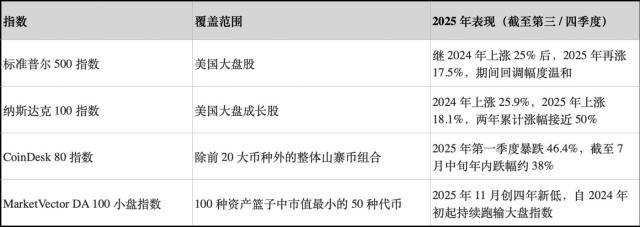Title: Will Crypto's Underperformance Last?
Author: Blockhead
Translated by: Bai Hua Blockchain
Due to the uncertainty surrounding U.S. tariffs, and exacerbated by the $150 million Ethereum hack at the Bybit trading platform last week, the loss of confidence among Altcoin investors has led to Bitcoin falling below $90,000 and reaching its lowest level since November 18 on Tuesday.
Bitcoin fell more than 7% to around $87,200, a drop of over $20,000 from the over $109,000 peak set on the day of Donald Trump's inauguration last week.
1. Macroeconomic Environment
With signs of a slowdown in the U.S. economy, recession concerns have resurfaced.
There is growing evidence that uncertainty over President Trump's policies has heightened Americans' anxiety about the economic future. U.S. consumer confidence plunged sharply last month, the biggest drop since August 2021.
Americans are cutting back on spending: According to a recent Wells Fargo survey, over half of consumers have delayed major life decisions due to concerns about the economic outlook and the fallout from Trump's tariff threats.
One-sixth have postponed further education plans, one-eighth have delayed retirement plans, and about one-third have put off home purchases.

Reflecting recession fears, safe-haven government bond prices have surged, with yields falling to their lowest in two months.
Exacerbating these concerns is Trump's renewed threat on Monday to impose a 25% tariff on imports from Canada and Mexico, after the levies were delayed last month.
Smaller Altcoins have been hit much harder than Bitcoin, which has fallen around 8% in the past week. According to CoinGecko data, the values of Doge, Solana and Cardano Token have declined by around 20%.
Crypto market sentiment has been generally downbeat since the start of the year, particularly in recent weeks amid the volatility around meme coins and the recent Bybit hack, further fueling this pessimism. The recent drop in Altcoin prices is unsurprising in the wake of the largest hack in history.
The current macroeconomic environment is also putting pressure on Altcoin investments. The bigger concern is that a small but worrying trend in risk assets could trigger a larger sell-off in the Altcoin market. Wall Street is also not optimistic, with the "Big Seven" stocks already in correction territory.
Tuesday was a turbulent day for the U.S. stock market, with stocks fluctuating around record levels for most of 2025. The seven giants that drove the U.S. stock market to a 54% gain in two years have now plummeted significantly.
On Tuesday, the Bloomberg "Big Seven" index fell 3.4%, now down more than 10% from the record high set on December 17. During this period, the total market value of these seven companies has shrunk by $1.6 trillion. Tesla is one of the biggest decliners, down 37%.

Despite the stock market decline, we are seeing a significant decoupling between Altcoins and U.S. stocks. This year, the correlation between Bitcoin and the Nasdaq has dropped sharply, and the overall market sentiment towards Altcoins is currently negative.
"The Altcoin market is mired in negative sentiment, mainly due to a series of meme coin scandals and rug pulls," said Martin Leinweber, Head of Digital Asset Research & Strategy at MarketVector Indexes and author of "Mastering Crypto Assets." He added, "High-profile scams like the Libra Coin incident in Argentina, Trump Coin, and other meme Tokens have severely undermined investor confidence, leading to significant price drops in Solana and other Altcoins."
While Solana remains one of the most scalable, low-cost, and fast blockchains, it is now referred to as the "Memecoin Chain." Due to various FUD, a lot of capital has flowed from Solana to Ethereum and other networks. But Solana's core strengths remain: it is not just a hub for meme coins, but also hosts DeFi, AI applications, real-world assets (RWA), and next-generation financial tools.
Meanwhile, prior to Tuesday's plunge, Bitcoin prices had been fluctuating in a narrow range below $100,000, leading many traders to believe the Altcoin bull market has ended, prompting them to sell Bitcoin.
But is this really accurate?

Source: Total Return Index (Base = 100), MarketVector Indexes
The changing U.S. Altcoin policy landscape has exacerbated the shift in market sentiment, further widening the "decoupling" between Altcoins and traditional stock markets. Leinweber said, "The breakdown in the correlation between Altcoins and stock markets is highly unusual, especially given the still risk-on macroeconomic environment."
With the weakening of the U.S. dollar, the head of MarketVector Indexes expects Altcoins and other risk assets to benefit as they have in the past. He said, "Considering this situation, Altcoins are unlikely to remain depressed for long. Capital flowing into stocks will eventually return to the digital asset market."
2. Altcoin Bottom: Have We Reached the Bottom?

Leinweber said that currently over 93% of the top 100 Altcoin Tokens are trading below their 90-day moving average. This severe market condition typically occurs before a market bottom, rather than persisting long-term.
The Crypto Fear & Greed Index, which tracks social media activity, volatility, trends, and prices, has recently fallen to a five-month low of 25, reflecting the growing pessimism in the market. With the uncertainty around Trump's tariff policy, Altcoin prices continue to slide.
Some analysts are starting to consider whether it's time to "buy the dips." Looking ahead, Standard Chartered's Global Head of Digital Assets Research, Geoffrey Kendrick, said Bitcoin could benefit from the decline in U.S. bond yields, a shift driven by a risk-off sentiment in the market following last Friday's PMI report, and expects a potential rebound in the medium term.
"But it's not time to buy the dips yet, the market could drop to around $80,000," Kendrick added.
Bernstein analysts reiterated their forecast for Bitcoin to reach $200,000 by year-end, and traders are closely watching upcoming U.S. inflation data for potential bullish signals, especially if the data trends towards the Fed's target.
However, Trump's policies have already started to negatively impact Altcoin assets and the broader risk market. The uncertainty over whether tariffs are a negotiating tactic or an actual threat is unsettling many investors.
Michael Hartnett, strategist at Bank of America, said "skepticism about the S&P 500's trajectory" is growing as market risks continue to mount.
Even so, the Wall Street benchmark is only 2.6% off the record high set last week.
In an interview with Bloomberg TV today, Hartnett warned that if stocks fall another 6%, the government may take action to stop the decline.
At the same time, Elon Musk's "Government Efficiency Department" is still actively seeking government positions and budget cuts in Washington. Investors are trying to quantify the impact of this cleansing on the Federal Reserve's interest rate trend, and the market's pessimistic sentiment is very obvious.
Bloomberg economist Anna Huang said that if DOGE can achieve a $100 billion budget cut, it would be enough to reduce the consumer price index by 0.2 percentage points. If the reduction is larger, reaching $600 billion, this would be equivalent to a reduction of 0.8 percentage points. She believes that if this happens, the Federal Reserve will have to cut interest rates further. "Expect a rate cut in 2026 = underestimating Elon," Anna said.
After Trump's latest tough rhetoric on tariffs and Beijing, concerns about stricter chip restrictions on China have led to a sharp drop in semiconductor stock prices. Intel and Nvidia's stock prices fell 1.5% and 2%, respectively, while the Netherlands' ASML and ASMI fell 2%. Tokyo Electron in Japan fell 4.9%. Stocks related to cryptocurrencies are also falling as the price of Bitcoin has fallen below $90,000, hitting a low since mid-November. This reverses some of the stock market gains after Trump's re-election. Microstrategy's stock price fell more than 6%, and Coinbase fell more than 5%.
3. Analysis of U.S. Treasury Yields
During Trump's first term, the stock market was the most important indicator for this real estate tycoon-turned-president. However, as Trump's second term enters its second month, the White House's focus has shifted to a new indicator: the 10-year Treasury yield.
Musk and Treasury Secretary Scott Baesent mentioned lowering market borrowing costs as a goal, a goal that echoes the policies of President Bill Clinton's era.
They need to focus on the bond market, especially the 10-year Treasury yield, as it directly affects the borrowing costs of homebuyers and large U.S. companies. It is not yet clear how the market will react to Baesent's proposed deficit reduction and Musk's criticism of government bureaucracy. Investors still maintain a certain expectation of success.
Over the past few weeks, U.S. Treasuries have outperformed interest rate swaps of the same maturity. However, most bondholders are still looking for observable, substantive results.
Currently, the trend of risk aversion still exists, and the overall macroeconomic dynamics also show certain pressures.







